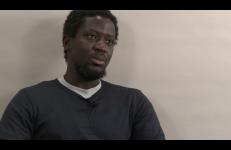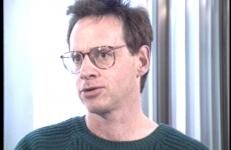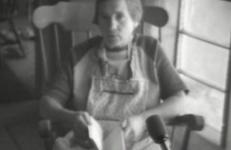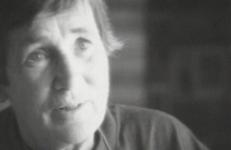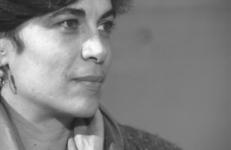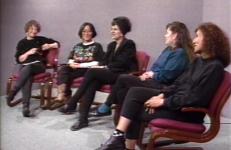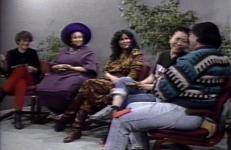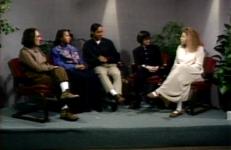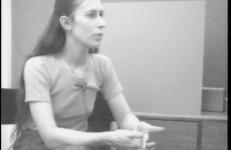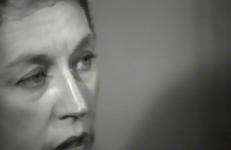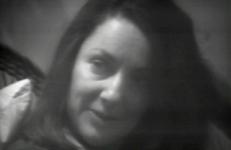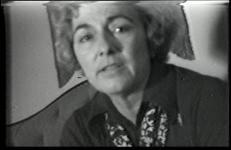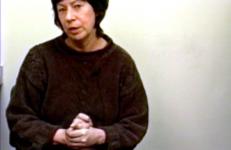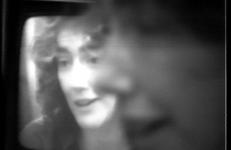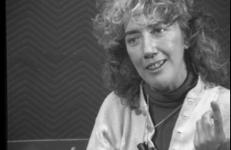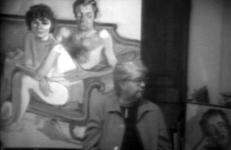Born in 1987, Ibrahim Mahama is an artist and author who creates monumental installations out of materials originating from Ghana, Mahama's home. Described in The Guardian as "a junkyard utopian", he investigates the conditions of supply and demand in African markets, often making work with materials like cocoa and jute sacks.
Interview
John Malpede is a performance artist and Director of the Los Angeles Poverty Department (LAPD), a performance art and theater group whose members include the city’s homeless. Through LAPD, Malpede provides an opportunity for homeless people to articulate the reality of their lives for themselves and audiences. Malpede was well known for his collaboration with performer Gill Gordh as Dead Dog and Lonely Horse. In one performance he took on the role of a street person, contrasting the wealth and excess of the 1984 Olympics in Los Angeles with the city’s struggle against homelessness.
Originally from Canada, Agnes Martin (1912-2004) moved to the U.S. in 1931. Martin lived in Taos, New Mexico from 1954 to 1957, and then moved to New York, where she established her name as an important minimalist painter.
Originally from Canada, Agnes Martin (1912-2004) moved to the U.S. in 1931. Martin lived in Taos, New Mexico from 1954 to 1957 and then moved to New York, where she established her name as an important minimalist painter. Her work differed conceptually from the minimalist movement in that it was anti-intellectual and intensely spiritual, and her grids represented meditative reflections on Taoism.
There are approximately 30,000 Filipino guest workers living within the State of Israel. The majority are female and work as caregivers for the elderly or sick. In Tel Aviv they live in shanty town conditions around the central bus station also known as the ‘Tachana Mercazit’. On Saturdays, buses in the Tachana do not work, and this giant modernist building is occupied by guest workers, who spend their time shopping, partying and socializing in bars, clubs and shops within the compound. Beauty contests are very popular among Filipinos both at home and abroad.
Maya Onoda, a young Japanese artist, transforms everyday materials into art, referring to them as her “nomadic home.” She finds beauty in mundane objects and gives them new life through her creative process. Living away from her home country, Onoda views this approach as deeply rooted in her Japanese culture and influenced by her mother.
Annette Michelson is a founding editor of the journal October and former professor of cinema studies at New York University. Before starting October, Michelson was the film critic for Artforum. Michelson’s influential work has focused on modernity, Russian and French avant-garde film, and American underground cinema.
Mary Miss (b.1944) is an American environmental artist who works with concepts of illusion, distance, and perception. Her site-specific work frequently uses both ancient and modern architecture as references. Miss's 1977 installation Perimeters/Pavilions/Decoys at the Nassau County Museum of Art, served as one of Rosalind Krauss's inspirations when she defined postmodern sculpture in her article, "Sculpture in the Expanded Field."
Joan Mitchell (1925-1992) was a "second generation" abstract expressionist painter and printmaker. She was an essential member of the American Abstract expressionist movement, and one of the few female painters to gain critical and public acclaim in the era.
The second in a series of cross-cultural symposia organized by Lucy Lippard, the four artists interviewed here—Jolene Rickard, Robbie McCauley, Judy Baca, and May Sun—discuss their work and its cultural contexts. Moderated by Lucy Lippard.
The third in a series of cross-cultural symposia organized by Lucy Lippard, the four artists interviewed here—Jean Lamar, Hung Liu, Lorna Simpson, and Kathy Vargas—discuss their work and its cultural contexts. Moderated by Lucy Lippard.
The fourth in a series of cross-cultural symposia organized by Lucy Lippard, the four artists interviewed hereÑJapanese-American painter and political activist Betty Kano, conceptual and performance artist Lorraine O'Grady, Hopi weaver Ramona Sakiestewa, and Chicana narrative and installation artist Celia Alvarez Muñoz–discuss their work and its cultural contexts.
The fifth in a series of cross-cultural symposia organized by Lucy Lippard, the four artists interviewed here–Tejana tableaux artist Santa Barranza, Taiwanese video and interactive installation artist Shu Lea Cheang, African-American sculptor and installation artist Joyce Scott, Native-American photographer Hulleah Tsinhnahjinnie–discuss their work and its cultural contexts. Moderated by Lucy Lippard.
The sixth in a series of cross-cultural symposia organized by Lucy Lippard, the four artists interviewed here–gay activist and self portrait artist Lyle Ashton Harris, Chicano photographer and tourist Robert Buitron, Cherokee writer, curator, and video creator Rayna Green, photography critic and professor at University of California-Irvine Catherine Lord, and Chinese-American video artist Valerie Soe–discuss the role of photography and creation of culture. Moderated by Lucy Lippard.
The seventh in a series of cross-cultural symposia organized by Lucy Lippard, the four artists interviewed here–visual anthropologist Wendi Starr-Brown, Hapa video and performance artist Kip Fulbeck, Japanese-American artist Dorothy Imagire, Chicana mixed-media artist Yolanda López–address the role of mixed-race identity in their work. Moderated by Corissa Schweitz Gold.
Meredith Monk (b.1942) has been composing, choreographing, and performing since the mid-1960s. Monk is primarily known for her vocal innovations, including a wide range of extended techniques, which she first developed in her solo performances prior to forming her own ensemble. Her voice has a unique timbre, which she explores through a capella singing and speech. As a dancer and choreographer, she creates hybrid, theatrical productions that incorporate ritualistic movements, lighting effects, and small props.
A video collage that chronicles the issues and events that arose in Linda M. Montano’s life while she devoted a year to each of the seven chakras. Beginning as a piece devoted to themes of commitment and limitation, the work becomes a fascinating hybrid of art and life, as Montano experiences the onset of menopause, her mother’s death, her choice to enter and then leave a convent, the suffering of a stroke, and thoughts of her own death—all within the structural confines of an intense work of art.
Linda Montano (b. 1942) is an American performance and video artist. At the source of’s work is her search for a personal harmony and balance. She seeks to synthesize the intuitive processes that transforms the private self with the rationality and pragmatism of the public persona, extending this synthesis to both art and life. Her avowed interest lies in "learning how to live better through life-like artworks," with personal growth evolving out of shared experience, role adoption, and ritual.
Ree Morton (1936-77) was an American artist working with large-scale mixed media installations. Her mature career was brief, extending from 1971 to 1977. However, her output and growth during these years was unusually large. This was the first of two interviews Lyn Blumenthal and Kate Horsfield conducted with Morton; the second was for the journal Heresies in 1977.
In October 1969, the Videofreex visited the home of wealthy political and social activist, Lucy Montgomery, as she was hosting the Black Panther Party of Chicago during one of their most fraught times – the period just after Chairman Bobby Seale was wrongfully imprisoned for inciting riots at the Democratic National Convention a year earlier. This video documents an interview with the wife of Bobby Seale, Artie Seale. The video opens with a statement by Mrs.
Laura Mulvey published her seminal essay "Visual Pleasure and Narrative Cinema" in 1975; it has subsequently become one of the most influential work in film theory. Using a psychoanalytic methodology to discuss spectatorship, it was groundbreaking in its feminist critique of the sadistic, misogynistic mode of classical Hollywood cinema in which women were objects of fetishistic display for male viewers’ pleasure. She has also written extensively on melodrama, published three books, and co-directed six films, including Riddles of the Sphinx with Peter Wollen (1974).
Elizabeth Murray (1940-2007) was an American painter, printmaker and draughtsman. She studied at the Art Institute of Chicago (1958–62) and at Mills College, Oakland, CA (1962–4). Elizabeth Murray’s paintings have been referred to as “dandyish abstraction.” Her work is distinctive in its use of color, shape, and surface to evoke human characteristics, personalities or humor.
Elizabeth Murray (1940-2007) was an American painter, printmaker and draughtsman. She studied at the Art Institute of Chicago (1958–62) and at Mills College, Oakland, CA (1962–4). Elizabeth Murray’s paintings have been referred to as “dandyish abstraction.” Her work is distinctive in its use of color, shape, and surface to evoke human characteristics, personalities or humor. Murray is particularly well known for her shaped canvases, which date from 1976, on to which are painted both figurative and non-figurative elements.
In this interview, American writer, artist, performer Eileen Myles (b.1949) discusses the various philosophies that motivate her work, including the language of film, embodied performance, and the alienation evoked by bodily vulgarity. Myles links her wide range of artistic and literary practice with notions of abstraction, improvisation, and the mythology of gender, which she explores in relation to her own identity as a working, middle-class lesbian woman. She reflects on the significance of geographical locations, both New York City and San Diego, on her art, and shares how her past struggles with addiction have shaped her life and practice.
Alice Neel (1900-1984) is known for portrait paintings of well-known persons and eccentric New York street types. Neel worked as a figurative painter throughout the decades of WPA realism, postwar abstract expressionism, 1960s Pop, and 1970s minimalism. She persevered in her work despite a turbulent personal life and critical neglect that continued until the 1960s. Neel lived and worked in New York City from 1932 until her death in 1984.




